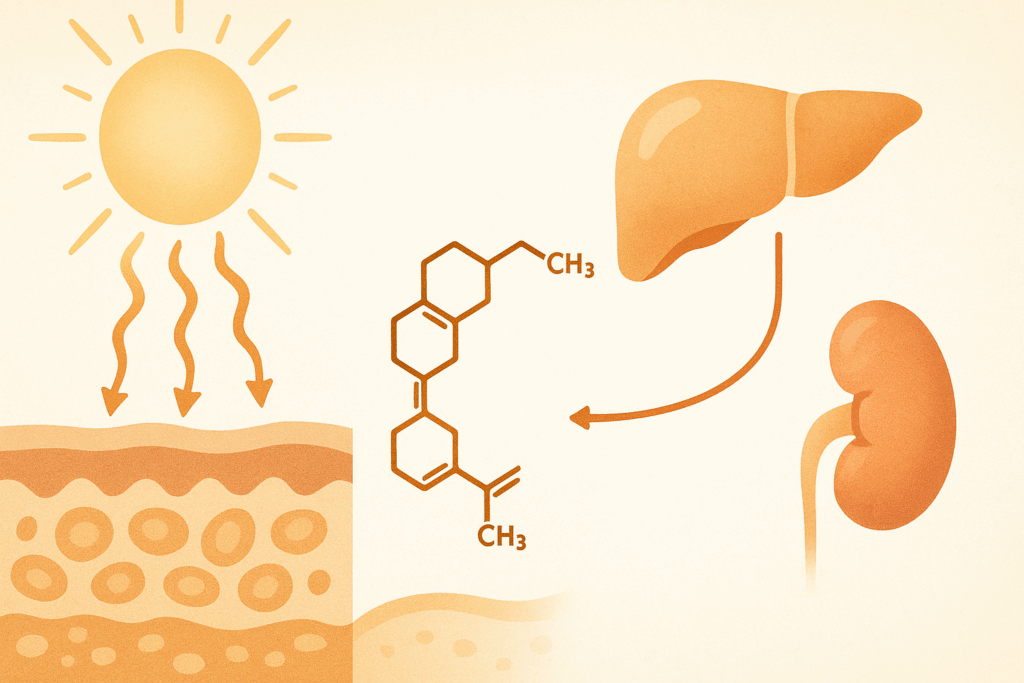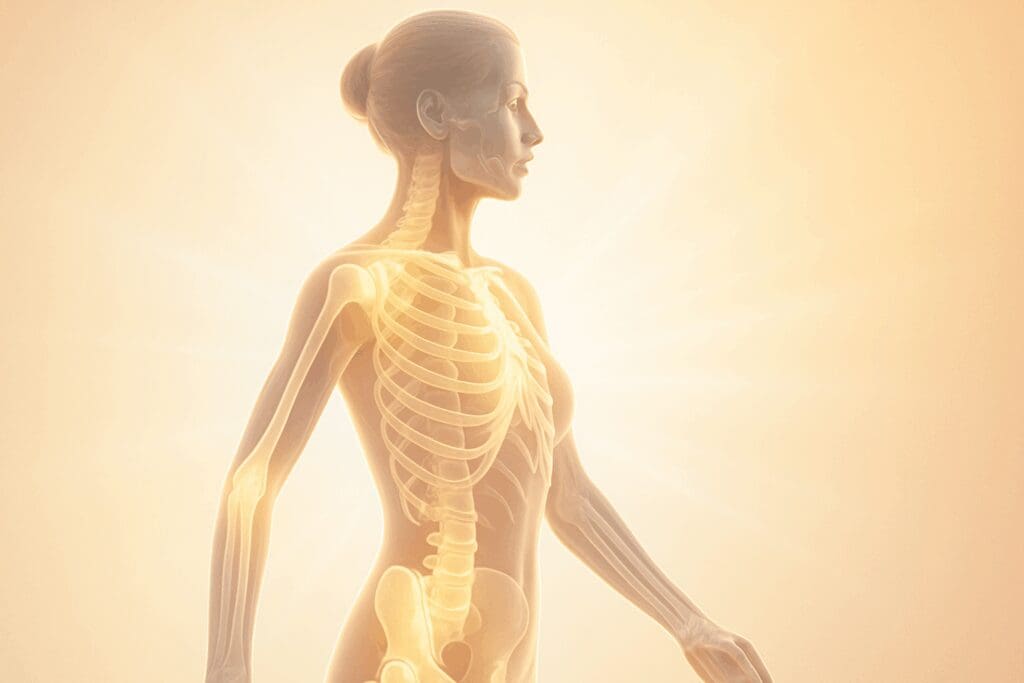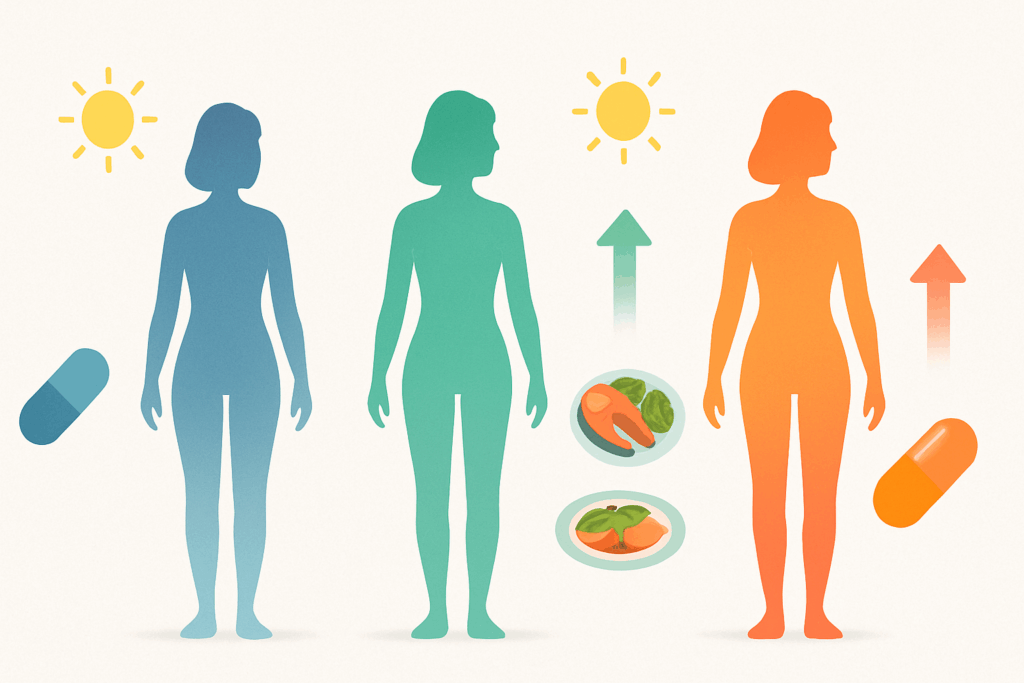In today’s fast-paced world, women are constantly balancing multiple responsibilities that demand optimal physical and mental well-being. This makes it more important than ever to understand how targeted nutritional choices can contribute to long-term health. Among the most vital nutrients for women across various life stages is vitamin D3. Exploring vitamin D3 benefits for women is not merely a matter of curiosity; it is a critical step in ensuring holistic well-being. From bone strength to mood regulation, and from hormonal balance to energy support, vitamin D3 plays a far-reaching role in women’s health. This guide provides a comprehensive look at how this nutrient functions in the body, its essential benefits, how to identify deficiencies, and ways to integrate it naturally through diet and lifestyle.
You may also like: 12 Foods You Should Eat Every Day for Powerful Nutritional Benefits

Understanding Vitamin D3: Structure, Function, and Unique Properties
Vitamin D3, also known as cholecalciferol, is a fat-soluble vitamin synthesized in the skin upon exposure to sunlight. Unlike many other vitamins, D3 functions more like a hormone in the human body, influencing a wide array of biological processes. It plays a central role in calcium absorption, bone mineralization, immune modulation, and cellular growth. The unique aspect of vitamin D3 is its endogenous synthesis, which means the human body can produce it with adequate sun exposure, a capability not shared by most other essential vitamins.
Vitamin D3 differs from vitamin D2 (ergocalciferol) in both structure and potency. Research consistently shows that vitamin D3 is more effective at raising and maintaining serum 25-hydroxyvitamin D levels, the biomarker used to assess vitamin D status. D3 is metabolized in the liver to form calcidiol and then in the kidneys to form calcitriol, the biologically active form. This two-step process underscores the importance of liver and kidney health in maintaining optimal D3 activity. Given these complexities, understanding how vitamin D3 is processed allows women to make informed decisions regarding supplementation and lifestyle changes.

Why Vitamin D3 Is Especially Important for Women
Although vitamin D3 is essential for everyone, women have unique physiological and hormonal dynamics that make its role even more critical. Hormonal fluctuations related to menstruation, pregnancy, and menopause can significantly influence how nutrients are absorbed and utilized. For instance, during pregnancy, vitamin D3 requirements increase due to fetal skeletal development, while during menopause, the decline in estrogen makes bones more susceptible to demineralization—a condition vitamin D3 can help mitigate.
Moreover, women are statistically more prone to autoimmune diseases such as multiple sclerosis, lupus, and rheumatoid arthritis. Since vitamin D3 is a key modulator of immune response, ensuring adequate levels may offer protective benefits. Additionally, vitamin D3 plays a role in mood regulation by influencing serotonin levels, an aspect particularly relevant given the higher prevalence of depression and anxiety among women. The intersection of physical and mental health underscores the need for gender-specific nutritional strategies, placing vitamin D3 at the forefront of women’s health protocols.

Vitamin D3 Benefits for Women: Supporting Bone Health and Beyond
When it comes to vitamin D3 benefits for women, the most widely acknowledged advantage lies in its role in bone health. Vitamin D3 enhances calcium absorption in the gut, helping maintain adequate serum calcium and phosphate concentrations, which are crucial for bone mineralization. This is especially important for postmenopausal women, who are at a higher risk of developing osteoporosis due to declining estrogen levels.
But the benefits do not stop at skeletal integrity. Vitamin D3 also supports muscle function, which in turn reduces the risk of falls and fractures. Emerging research suggests that adequate levels of vitamin D3 may lower the risk of chronic diseases such as type 2 diabetes, cardiovascular disease, and even certain cancers. Women with sufficient vitamin D3 levels often report better mood stability, fewer PMS symptoms, and improved energy levels, making it a cornerstone nutrient for comprehensive health.
Another key area is reproductive health. Vitamin D3 influences the production of sex hormones such as progesterone and estrogen, which are essential for regular menstrual cycles and fertility. Women trying to conceive may benefit from ensuring optimal vitamin D3 levels, as studies have indicated a correlation between sufficient levels and higher pregnancy success rates. Furthermore, vitamin D3 appears to play a role in the maintenance of a healthy pregnancy, potentially reducing the risk of complications like preeclampsia and gestational diabetes.

Addressing the Question: Does Vitamin D3 Give You Energy?
A common question among those exploring vitamin D3 supplementation is, “does vitamin D3 give you energy?” While vitamin D3 is not a direct energy-yielding nutrient like carbohydrates or fats, its indirect role in energy production is significant. Vitamin D3 supports mitochondrial function, which is crucial for cellular energy production. Mitochondria are responsible for converting nutrients into adenosine triphosphate (ATP), the energy currency of cells, and vitamin D3 helps regulate this conversion process.
Moreover, vitamin D3 contributes to mental alertness and reduces the likelihood of fatigue by modulating the immune system and reducing inflammation. Chronic low-grade inflammation can sap energy and contribute to conditions like chronic fatigue syndrome. Women who are deficient in vitamin D3 often experience symptoms such as tiredness, lethargy, and mood swings—all of which can mimic or exacerbate feelings of low energy. Therefore, while it does not provide energy in the traditional sense, vitamin D3 indirectly promotes sustained vitality and alertness.
The Interplay Between Vitamin D3 and Hormonal Balance
Hormonal balance is a complex and delicate system, particularly for women, whose endocrine profiles shift significantly during adolescence, monthly cycles, pregnancy, and menopause. Vitamin D3 acts on the endocrine glands and influences the production and regulation of hormones. It interacts with the pituitary gland, which is considered the master regulator of hormones, affecting thyroid function, adrenal output, and reproductive hormone synthesis.
Vitamin D3 receptors are found in reproductive organs such as the ovaries and uterus, suggesting a more intimate connection between this nutrient and reproductive health. In women with polycystic ovary syndrome (PCOS), a condition characterized by hormonal imbalance and insulin resistance, vitamin D3 supplementation has shown promise in improving menstrual regularity and reducing androgen levels. By influencing hormone receptors and signaling pathways, vitamin D3 contributes to a more stable hormonal environment, which can manifest in improved skin health, mood regulation, and reproductive function.
Mood and Mental Health: The Psychological Benefits of Vitamin D3
Another compelling area of research is the impact of vitamin D3 on mood and cognitive function. Numerous observational studies have linked low levels of vitamin D3 with increased incidence of depression, anxiety, and seasonal affective disorder (SAD). The presence of vitamin D3 receptors in areas of the brain involved in mood regulation, such as the prefrontal cortex and hippocampus, suggests a neurobiological basis for this connection.
Vitamin D3 enhances the synthesis of neurotransmitters like serotonin and dopamine, both of which are essential for emotional well-being. Women, particularly during the postpartum period or around menopause, are vulnerable to mood disorders, and optimizing vitamin D3 levels may serve as a non-pharmacological support strategy. While vitamin D3 is not a substitute for psychiatric treatment, its supplementation has been found to augment the effects of other therapeutic modalities, making it a valuable adjunct in mental health care.

Everyday Sources of Vitamin D3: From Sunlight to Superfoods
While the body can synthesize vitamin D3 through sun exposure, several factors can hinder this natural process. Geographic location, skin pigmentation, sunscreen use, and time spent indoors can all limit the skin’s ability to produce vitamin D3. Therefore, dietary sources become increasingly important, especially during the winter months or for individuals living in northern latitudes.
Fatty fish such as salmon, mackerel, and sardines are among the richest natural sources of vitamin D3. Egg yolks, beef liver, and fortified foods like milk, orange juice, and cereals also contribute to dietary intake. For those following plant-based diets, supplementation may be necessary, as few vegan foods naturally contain vitamin D3. Understanding the bioavailability and absorption efficiency of these sources is crucial; pairing vitamin D3-rich foods with dietary fats enhances absorption due to its fat-soluble nature.
Incorporating superfoods that support the absorption and function of vitamin D3 can further optimize health outcomes. Foods rich in magnesium and vitamin K2, such as leafy greens, nuts, and fermented products, play synergistic roles in calcium metabolism and bone health. These nutritional partnerships reinforce the importance of a well-rounded diet in maximizing the benefits of vitamin D3.

Vitamin D3 Supplementation: How Much Is Enough?
Given the difficulty of obtaining sufficient vitamin D3 through diet and sunlight alone, many women turn to supplementation. The Recommended Dietary Allowance (RDA) for vitamin D varies by age, health status, and life stage. For most adult women, the RDA is 600 to 800 IU per day, but some experts suggest higher doses may be necessary to achieve optimal serum levels, especially in cases of deficiency.
High-dose supplementation should always be approached with caution and under medical supervision, as excessive vitamin D3 can lead to toxicity. Symptoms of overdose include hypercalcemia, kidney stones, and gastrointestinal discomfort. Blood tests measuring 25-hydroxyvitamin D are the gold standard for assessing vitamin D status and guiding personalized supplementation strategies.
When selecting a supplement, look for third-party testing and opt for formulations that include co-factors like magnesium, which aids in D3 metabolism. Liquid, soft gel, and spray forms may offer superior absorption compared to tablets, particularly for individuals with malabsorption issues. Consistency is key, and taking vitamin D3 at the same time daily with a fat-containing meal can enhance bioavailability.
Identifying and Addressing Deficiencies in Women
Vitamin D deficiency is surprisingly common among women worldwide, with prevalence rates ranging from 20% to 80%, depending on geographic location, lifestyle, and genetic factors. Symptoms of deficiency are often nonspecific, including fatigue, muscle weakness, joint pain, and increased susceptibility to infections. Because these symptoms overlap with many other conditions, vitamin D deficiency is frequently underdiagnosed.
Women with darker skin tones, those who wear clothing that covers most of the body, and those who avoid sun exposure for medical or cultural reasons are particularly at risk. Certain health conditions such as obesity, celiac disease, and chronic kidney disease can impair vitamin D metabolism, further increasing the risk. Routine screening and awareness of risk factors can aid in early detection and intervention.
Correcting a deficiency requires a multi-pronged approach that includes supplementation, dietary adjustments, and lifestyle modifications. Medical professionals may recommend loading doses of vitamin D3 followed by maintenance dosing. It is also essential to monitor serum calcium and phosphorus levels during treatment to avoid complications. With consistent care, most women can restore optimal vitamin D3 levels and experience improvements in overall health and well-being.
Vitamin D3 Benefits for Women in Pregnancy and Postpartum Health
During pregnancy, the demands on a woman’s body increase exponentially, making adequate nutrient intake vital for both maternal and fetal health. One of the most compelling vitamin D3 benefits for women is its role in promoting a healthy pregnancy. It supports fetal bone development, modulates immune function to reduce the risk of complications, and contributes to maternal mental health.
Low vitamin D3 levels in pregnancy have been associated with increased risks of gestational diabetes, preeclampsia, and low birth weight. Ensuring adequate levels can help mitigate these risks and promote a smoother pregnancy experience. The postpartum period is another critical window, during which vitamin D3 supports lactation and reduces the risk of postpartum depression, a condition that affects a significant percentage of new mothers.
Supplementation during pregnancy should always be guided by a healthcare provider, as excessive intake can have adverse effects. Prenatal vitamins often include vitamin D3, but individual needs may vary based on baseline levels and other risk factors. Continued monitoring and tailored interventions ensure that both mother and baby benefit from optimal vitamin D3 levels.
Aging Gracefully: Vitamin D3 and Long-Term Wellness for Women
As women age, the risk of chronic diseases and mobility issues increases. Vitamin D3 continues to play a pivotal role in aging gracefully by supporting musculoskeletal health, cognitive function, and immune resilience. The decline in bone density during and after menopause can be mitigated with adequate vitamin D3, helping maintain independence and quality of life.
In addition to bone and muscle health, emerging evidence suggests that vitamin D3 may play a role in reducing the risk of age-related cognitive decline. Its anti-inflammatory properties and role in neurotransmitter regulation may offer neuroprotective effects, supporting memory, focus, and emotional balance.
Moreover, the immune system tends to weaken with age, making older adults more susceptible to infections and slower recovery times. Vitamin D3 strengthens innate immunity and enhances the body’s ability to ward off pathogens. For aging women, maintaining optimal vitamin D3 levels can contribute to a more vibrant, active, and fulfilling life.
Frequently Asked Questions About Vitamin D3 and Women’s Health
How do vitamin D3 benefits for women change across different stages of life?
Vitamin D3 benefits for women shift meaningfully as they move through adolescence, reproductive years, and into post-menopause. During adolescence, vitamin D3 supports bone accrual, which lays the foundation for long-term skeletal health. In the reproductive years, it contributes to hormone regulation and fertility, especially by supporting estrogen and progesterone balance. During pregnancy and breastfeeding, adequate vitamin D3 is crucial for fetal development and maternal immune health. Postmenopausal women benefit from vitamin D3’s protective effect against bone demineralization and chronic inflammation, both of which accelerate with age. Tailoring vitamin D3 intake to life stages helps women address specific physiological demands more effectively.
Can vitamin D3 support women with autoimmune conditions like lupus or Hashimoto’s thyroiditis?
Yes, vitamin D3 plays an important immunomodulatory role, which can be beneficial for women living with autoimmune diseases. By reducing pro-inflammatory cytokines and enhancing the activity of regulatory T-cells, vitamin D3 helps calm autoimmune reactions. Women with lupus or Hashimoto’s often exhibit lower serum vitamin D levels, and supplementation has been shown to alleviate fatigue and improve quality of life in some cases. It’s not a replacement for primary treatment, but it may reduce disease flare-ups and symptom severity. Individualized dosing and consistent monitoring are key to leveraging its benefits without triggering hypervitaminosis.
What are the social and psychological implications of vitamin D3 deficiency in women?
Vitamin D3 deficiency doesn’t only manifest in physical symptoms—it can also have far-reaching psychological and social effects. Women experiencing fatigue, low mood, or irritability due to deficiency may withdraw from social interactions or experience a drop in productivity at work and home. Chronic mood imbalances can erode self-esteem and lead to social isolation, particularly if misattributed to stress or personality traits. Restoring optimal vitamin D3 levels has been associated with enhanced emotional regulation, increased motivation, and improved interpersonal relationships. These social ripple effects highlight the need to treat deficiency not just as a physical concern but as a multidimensional wellness issue.
Does vitamin D3 give you energy in physically demanding lifestyles like athletic training or caregiving?
In physically demanding lifestyles, such as those led by athletes or caregivers, vitamin D3 serves as a foundational support rather than a direct energy stimulant. While it doesn’t supply caloric energy, vitamin D3 enhances mitochondrial efficiency, allowing cells to produce energy more effectively. This can result in better muscular endurance, reduced fatigue during recovery, and even fewer performance dips during menstruation. Women in high-output roles often overlook micronutrient needs while focusing on macronutrients, but optimizing vitamin D3 can amplify training results and reduce burnout. The phrase “does vitamin D3 give you energy” reflects this broader biological synergy rather than a caffeine-like boost.
How do vitamin D3 benefits for women intersect with modern skincare and dermatology?
Emerging research in dermatology has begun to explore how vitamin D3 benefits for women extend to skin health. Vitamin D3 influences keratinocyte proliferation and differentiation, which are essential for a resilient skin barrier. Some studies suggest that topical or systemic vitamin D3 may improve conditions like psoriasis, eczema, and even adult acne by reducing inflammation and enhancing immune response in the skin. Additionally, vitamin D3 may help mitigate UV-induced skin damage and support faster healing of wounds. These insights are shifting the conversation from vitamin D3 as a bone-supporting nutrient to one with visible aesthetic and dermatological applications.
Can vitamin D3 help with brain fog and concentration issues in women juggling multiple responsibilities?
Women balancing work, family, and personal life often report cognitive sluggishness commonly referred to as brain fog. While multiple factors contribute to this, vitamin D3 deficiency is increasingly recognized as a modifiable contributor. By supporting neurotransmitter production—especially dopamine and serotonin—vitamin D3 enhances neural communication and mental clarity. It also modulates inflammation in the brain, which can negatively impact memory and focus. Women supplementing with vitamin D3 often report improved attention span, fewer forgetful moments, and better task-switching abilities. For those asking “does vitamin D3 give you energy,” cognitive vitality is a compelling dimension of its overall effect.
Are there genetic factors that affect how women metabolize vitamin D3?
Yes, genetic polymorphisms in the vitamin D receptor (VDR) gene can affect how efficiently women utilize vitamin D3. Some individuals may require higher doses to achieve the same physiological impact due to variations in receptor sensitivity. Additionally, genes affecting liver and kidney function can influence the conversion of vitamin D3 into its active form. Personalized health tests can help identify such variants, allowing for more precise supplementation. Understanding one’s genetic predisposition is especially relevant for women with a family history of osteoporosis or autoimmune disease, as it may explain persistent low levels despite adequate intake.
Why are vitamin D3 benefits for women particularly relevant in urban environments?
Urban living presents unique challenges that make vitamin D3 benefits for women even more crucial. High-rise architecture, indoor-centered work cultures, and air pollution significantly reduce effective sun exposure. As a result, women in cities are more likely to be vitamin D3 deficient, even if they spend time outdoors. Coupled with sedentary lifestyles and processed diets, this deficiency can exacerbate fatigue, poor immunity, and hormonal imbalances. Proactively managing vitamin D3 intake through supplementation or fortified foods becomes essential for urban women aiming to maintain energy, mood, and bone strength.
How does vitamin D3 influence metabolic health and weight regulation in women?
Vitamin D3 contributes to metabolic health by influencing insulin sensitivity, fat cell behavior, and inflammation—all of which are critical in weight regulation. Women with higher vitamin D3 levels tend to have better glycemic control, which reduces cravings and stabilizes energy. There is also evidence that vitamin D3 may inhibit the formation of new fat cells and support the breakdown of existing ones. While it is not a weight loss supplement per se, vitamin D3 acts as a regulatory agent that optimizes other metabolic processes. For women struggling with weight plateaus despite diet and exercise, checking vitamin D3 levels can reveal a hidden barrier to progress.
What role does vitamin D3 play in reducing healthcare disparities among women of color?
Women of color, especially those with darker skin tones, face a higher risk of vitamin D3 deficiency due to melanin’s natural blocking of UVB rays needed for synthesis. This can exacerbate existing health disparities, as deficiency correlates with increased risks for hypertension, diabetes, and autoimmune conditions. Increasing awareness of vitamin D3 benefits for women in these populations is vital for preventive care and health equity. Healthcare providers are beginning to recommend tailored screening and supplementation strategies to bridge this gap. Addressing these imbalances can lead to more inclusive, proactive approaches in women’s health and reduce long-term systemic inequities.
Conclusion: Prioritizing Vitamin D3 in a Holistic Nutrition Plan for Women
The comprehensive exploration of vitamin D3 benefits for women underscores its indispensable role in every stage of life, from adolescence and fertility to pregnancy and graceful aging. While often overshadowed by more popular nutrients, vitamin D3 quietly supports a vast network of physiological processes that collectively influence health, vitality, and resilience. Addressing the question “does vitamin D3 give you energy?” reveals a nuanced understanding of how this nutrient indirectly boosts stamina and mental clarity by enhancing cellular function, hormonal balance, and immune response.
Incorporating vitamin D3 into a holistic nutrition plan involves more than simply taking a supplement. It requires an integrated approach that considers sun exposure, dietary intake, lifestyle habits, and individualized health needs. For women striving to optimize their physical and mental well-being, understanding and prioritizing vitamin D3 is not just advisable—it is essential. In doing so, women empower themselves with the tools needed to take charge of their health, energize their daily lives, and invest in a future of sustained wellness and vitality.
Further Reading:
Vitamin D may improve your energy levels. Here’s how much you need each day



